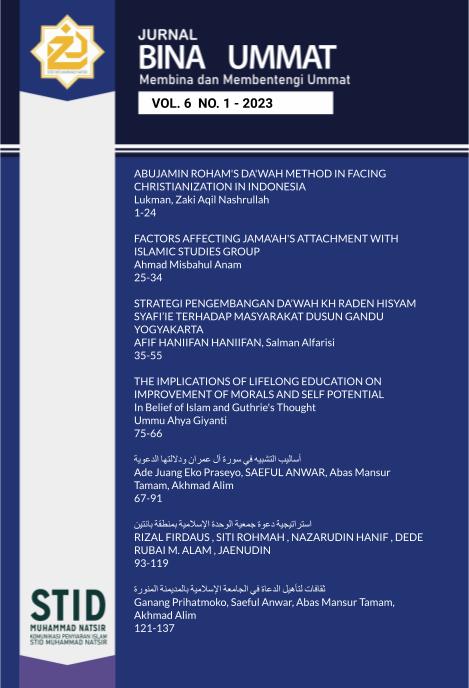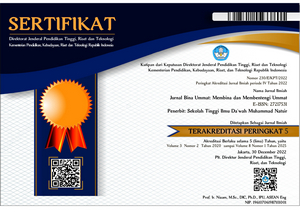?????? ??????? ?? ???? ?? ????? ???????? ???????
DOI:
https://doi.org/10.38214/jurnalbinaummatstidnatsir.v6i1.171Keywords:
Al-Imran, Tashbeh, DawahAbstract
The aim of studying this topic is to know the implications of the tashbehs mentioned in Surah Al-Imran related to the dawah aspect. In carrying out this research, the researcher used two scientific approaches, namely the analytical descriptive approach, and the deductive approach. These two approaches paved the way for the researcher to analyze the tashbehs in Surah Al-Imran, and then discover and deduce from those tashbeh meanings related to the dawah side to be a da'wah approach method applied in the fields of Islamic advocacy. The study concluded that in Surah Al-Imran there are methods of tashbehs, and they carry moral connotations related to the dawah aspect. These indications can be extracted from methods and modalities used as a methodology for the call to spread Islam in societies. By using tashbehs methods in the dawah process, it will be better, because the dawah materials are easier to understand and stronger to influence. Also, the tashbehs method enhances the emotional relationship between the dae and the mado, and between the preacher and the listener, making the dawah more acceptable to people. Thus, it can be said that the use of analogy as an advocacy tool has a positive impact on spreading the beauties of Islam in societies.
Published
Issue
Section
This work is licensed under a Lisensi Creative Commons Atribusi 4.0 Internasional.
Authors who publish with this journal agree to the following terms:
- Authors retain copyright and grant the journal right of first publication with the work simultaneously licensed under a�Creative Commons Attribution License that allows others to share the work with an acknowledgment of the work's authorship and initial publication in this journal.
- Authors are able to enter into separate, additional contractual arrangements for the non-exclusive distribution of the journal's published version of the work (e.g., post it to an institutional repository or publish it in a book), with an acknowledgment of its initial publication in this journal.
- Authors are permitted and encouraged to post their work online (e.g., in institutional repositories or on their website) prior to and during the submission process, as it can lead to productive exchanges, as well as earlier and greater citation of published work (See�The Effect of Open Access).




